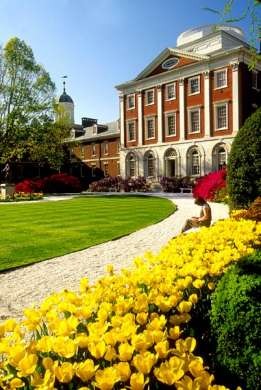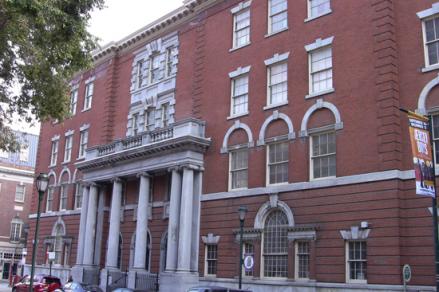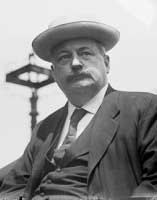Related Topics
Franklin Inn Club
Hidden in a back alley near the theaters, this little club is the center of the City's literary circle. It enjoys outstanding food in surroundings which suggest Samuel Johnson's club in London.
Philadelphia Legal Scene
The American legal profession grew up in this town, creating institutions and traditions that set the style for everyone else. Boston, New York and Washington have lots of influential lawyers, but Philadelphia shapes the legal profession.
Historical Preservation
The 20% federal tax credit for historic preservation is said to have been the special pet of Senator Lugar of Indiana. Much of the recent transformation of Philadelphia's downtown is attributed to this incentive.
Customs, Culture and Traditions
Abundant seafood made it easy to settle here. Agriculture takes longer.
Sixth and Walnut over to Broad and Sansom
 In 1751, the Pennsylvania Hospital at 8th and Spruce was 'way out in the country. Now it is in the center of a city, but the area still remains dominated by medical institutions.
In 1751, the Pennsylvania Hospital at 8th and Spruce was 'way out in the country. Now it is in the center of a city, but the area still remains dominated by medical institutions.
HSP: Philadelphia's Attic

|
| Historical Society of Pennsylvania |
There was a time when the mission of the HSP (Historical Society of Pennsylvania) was clearly and proudly centered on the history of Philadelphia's old families. There generally comes a time in every family when its accumulation of stuff requires facing the fact that many possessions are too valuable to sell and too bulky to store. HSP in time became a place where families contributed these objects of memory and value, at least keeping them out of the hands of antique dealers when dusting and ensuring them became a burden. When many families entered into such a joint venture, the shared goals and experiences created a tradition over time which was reassuring to the donors. The famous lawyer Howard Lewis came to the board of HSP at a time when it was facing up to some of its own problems.

|
| Boies Penrose |
The then Board Chairman Boises Penrose came to the young lawyer one day and told him it was time he joined the board. Well, why? Because your grandfather was once Chairman of the Board; no other explanation was offered. Howard Lewis recounts that it was his introduction to a Philadelphia fact: some board appointments are hereditary. He dutifully joined.
It became apparent that HSP was a museum of immensely interesting artifacts, including decorations used at the Machianza of 1778, a copy of the handwritten originals of the Declaration of Independence and the Constitution, and ten thousand other curious of great interest. It was a place to visit one's family relics, it was a great place to hold a party. It had a three million dollar endowment in 1969. But it had a big problem: essentially no one visited the museum. It isn't hard to imagine the anguish waiting for anyone who stirred up the hornet's nest by pointing out the obvious problem. You can't fire hereditary directors, so hereditary directors don't budge in an argument. You can make hired staff into scapegoats and fire them; that doesn't accomplish much, although it is commonly tried. The Genealogy Society is a natural partner of Philadelphia's attic, but although the two partners were intimately mixed, natural partners who can't be fired add to the scene.
Things went on. Boies Penrose held board meetings which lasted precisely forty-five minutes. He had a train to Devon to catch at 5:15, so meetings ended at 4:45 PM, precisely. Even when a speaker was in mid-sentence, the gavel banged down at 4:45. Eventually this impasse was broken by reaching an agreement with the Atwater Kent Museum to the effect that historical three-dimensional objects would go to the Atwater Kent, freeing up 40% more library space for the two-dimensional papers, maps, and documents which were to become the main focus of the new HSP. More separation between HSP and the Genealogy Society was effected. Much of this was made possible by the extraordinary investment ability of Ralph Kynette, who had run the endowment up to $18 million, in spite of maintaining a spending rule of 9%. There are not many non-profit organizations which can match such a performance.
The reorganized HSP floundered a bit, and then it had the good fortune to enter into a merger with the Balch Institute. The Balch also had a store of valuable papers, but its main mission was educational. The addition of this educational effort to the more static museum and library functions has allowed the recruitment of ambitious staff, and a considerable redirection from Olde Philadelphia to the city as it now is.
In the course of the many reexaminations which all this reorganization stirred up, some familiar issues in non-profit administration had to be faced. The American Museum Association is firm in its principles that no asset in the archives of a museum may ever be sold, except to purchase some other asset which comes closer to the museum's stated mission. The underlying sense of this rule is plain: it would be unfortunate for paid staff to sell artwork for the purpose of sustaining or raising their own salaries. Unfortunately, in a great many instances, collection value has grown more rapidly than the size of the endowment to preserve the collection. That's about the size of the problem at the Barnes Museum, where collections worth many billions cannot be touched to raise money to protect and display them. It is confidently asserted that the Barnes has many objects in its basement which could easily correct its endowment imbalance, but the AMA rule prevents it. The Barnes must now be moved to a new county to overcome this impasse. It all seems like an awkward way to solve one problem by creating another, but the lawyer in Howard Lewis takes it in quite an unexpected direction.
It is his view that locking the museums of the nation in this position creates a constantly shrinking market in the artwork; when a museum acquires a piece of art it forces it to enter a one-way tunnel, never to reappear on the market. A constantly shrinking market of salable art raises prices, and it does so in a way that resembles a violation of the Clayton Antitrust Act, the beneficiaries of which are the art dealers, art collectors and artists of the world. Add to this injury to competition, the tax benefits of creating or holding a constantly appreciating market; and it really is an uncomfortable thing to consider in depth. The American Museum Association ought give serious consideration to finding alternative routes to its legitimate goals. One of the other probably unintentional results of this rule are that the donation of a valuable piece of art to a museum is very likely to lead to its instant sale for cash. The reasoning here is that the donation has not yet been "taken into the collection", and thus it can be sold without violating the Museum Association rule. People who wear wigs while sitting on a bench may consider this a valid interpretation, but when you set about trying to fashion a better museum rule, this rebuttal seems highly contrived.
If we should someday set about to re-examine what we are doing in the legal thicket of museums, we might consider how the principles of non-profit accounting for museums might be fundamentally modified. Since a non-profit is thought to generate no profits, its financial health cannot be measured by the size of its profits. Consequently, it is traditional to account for the finances of a non-profit by measuring whether its assets have grown or declined. However, conducting an annual appraisal of all the artwork in a museum that never sells anything is a monumental expense without any other purpose than to satisfy the accounting rule. Consequently, I'll tell you a little secret. Absolutely everyone ignores the issue, and the annual audits are totally uninformative if not misleading. Who's going to hang the bell on this cat?
Originally published: Friday, April 03, 2009; most-recently modified: Tuesday, May 21, 2019